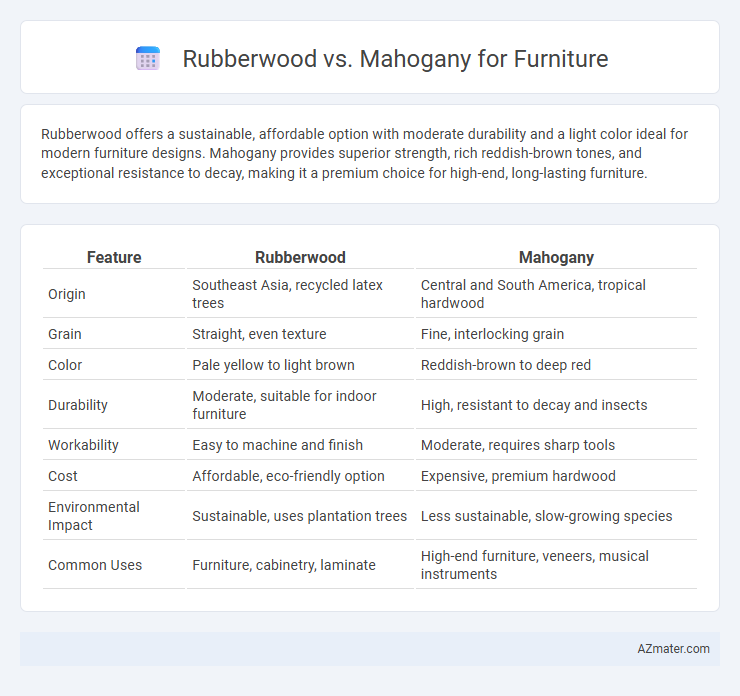Rubberwood offers a sustainable, affordable option with moderate durability and a light color ideal for modern furniture designs. Mahogany provides superior strength, rich reddish-brown tones, and exceptional resistance to decay, making it a premium choice for high-end, long-lasting furniture.
Table of Comparison
| Feature | Rubberwood | Mahogany |
|---|---|---|
| Origin | Southeast Asia, recycled latex trees | Central and South America, tropical hardwood |
| Grain | Straight, even texture | Fine, interlocking grain |
| Color | Pale yellow to light brown | Reddish-brown to deep red |
| Durability | Moderate, suitable for indoor furniture | High, resistant to decay and insects |
| Workability | Easy to machine and finish | Moderate, requires sharp tools |
| Cost | Affordable, eco-friendly option | Expensive, premium hardwood |
| Environmental Impact | Sustainable, uses plantation trees | Less sustainable, slow-growing species |
| Common Uses | Furniture, cabinetry, laminate | High-end furniture, veneers, musical instruments |
Introduction to Rubberwood and Mahogany
Rubberwood, derived from the Para rubber tree (Hevea brasiliensis), is a sustainable hardwood known for its light color, fine grain, and affordability in furniture manufacturing. Mahogany, a prized tropical hardwood from the Swietenia genus, features rich reddish-brown hues, exceptional durability, and natural resistance to decay, making it a premium choice for high-end furniture. Both woods offer distinct aesthetic and structural properties, influencing their selection based on durability, sustainability, and budget considerations.
Botanical Origins and Sources
Rubberwood, scientifically known as Hevea brasiliensis, is primarily sourced from Southeast Asia's plantations where it grows as a byproduct of the latex industry, making it an eco-friendly option. Mahogany, belonging to the genus Swietenia, originates from tropical forests in Central and South America and is prized for its rich, reddish-brown color and durability. The botanical distinction between Rubberwood and Mahogany reflects their different growth environments and wood characteristics, influencing their uses in furniture manufacturing.
Physical Properties and Appearance
Rubberwood features a light, pale yellow tone with a fine, straight grain, making it ideal for modern, minimalist furniture, while mahogany offers a rich, reddish-brown hue with a pronounced, interlocking grain that enhances traditional and luxury styles. Rubberwood is moderately dense at around 560 kg/m3, providing good durability and resistance to wear, whereas mahogany boasts a higher density of approximately 640-850 kg/m3, resulting in superior strength and longevity. The physical hardness of mahogany also surpasses rubberwood, making it better suited for intricate carving and high-stress furniture components.
Durability and Lifespan
Rubberwood, derived from the Para rubber tree, offers moderate durability and a lifespan of 10-15 years under proper care, making it a cost-effective option for furniture. In contrast, mahogany, known for its dense grain and high oil content, provides superior durability and can last over 100 years, resisting warping and insect damage. The longevity of mahogany furniture often justifies its premium price, especially in heirloom or high-end pieces.
Workability and Crafting Ease
Rubberwood offers excellent workability due to its light density and straight grain, making it easier to cut, shape, and finish compared to denser hardwoods. Mahogany, while more challenging to work with because of its hardness and interlocking grain, provides superior durability and a smooth finish when crafted skillfully. Both woods are favored in furniture making; Rubberwood is ideal for cost-effective, mass-produced pieces, whereas Mahogany suits high-end, detailed craftsmanship.
Environmental Impact and Sustainability
Rubberwood furniture is more environmentally sustainable due to its origin from the rubber tree plantations after latex extraction, promoting waste reduction and resource optimization. Mahogany, while prized for durability and aesthetics, often involves deforestation and habitat loss, contributing to significant ecological damage when sourced unsustainably. Choosing rubberwood supports eco-friendly practices by utilizing reclaimed timber from an existing agricultural industry, minimizing carbon footprint and preserving biodiversity.
Cost Comparison
Rubberwood offers a significantly lower cost compared to mahogany, making it a budget-friendly option for furniture production without sacrificing durability. Mahogany's higher price reflects its premium quality, rich color, and natural resistance to decay, often preferred for luxury and heirloom pieces. Buyers seeking cost-effective furniture with respectable strength typically choose rubberwood, while those prioritizing aesthetics and longevity invest more in mahogany.
Common Furniture Applications
Rubberwood is widely used for affordable, eco-friendly furniture such as dining tables, chairs, and bookcases due to its durability and light color, while mahogany is preferred for high-end, classic pieces like cabinets, bed frames, and ornate furniture because of its rich reddish-brown hue and fine grain. Rubberwood's resistance to warping and termites makes it ideal for mass-produced items, whereas mahogany's strength and ability to take polish well suit it for detailed carvings and luxury finishes. Furniture manufacturers often choose rubberwood for budget-sensitive projects and mahogany for premium, heirloom-quality products.
Maintenance and Care Requirements
Rubberwood furniture requires regular dusting and occasional polishing to maintain its light, natural finish while being resistant to pests due to its dense grain. Mahogany demands more careful upkeep, including protection from direct sunlight and humidity to prevent warping and fading, with periodic oiling or waxing to preserve its rich, deep color. Both woods benefit from avoiding abrasive cleaners and excess moisture, but rubberwood is generally lower-maintenance and more resistant to common household wear.
Rubberwood vs Mahogany: Which is Best for Your Furniture?
Rubberwood offers an affordable, eco-friendly option with a light color and moderate durability, making it ideal for budget-conscious furniture buyers seeking versatile styles. Mahogany features a rich, reddish-brown hue with exceptional strength and natural resistance to decay, favored for high-end, durable pieces with a timeless appearance. Choosing between rubberwood and mahogany depends on priorities like cost, aesthetic preference, and long-term durability for your furniture needs.

Infographic: Rubberwood vs Mahogany for Furniture
 azmater.com
azmater.com